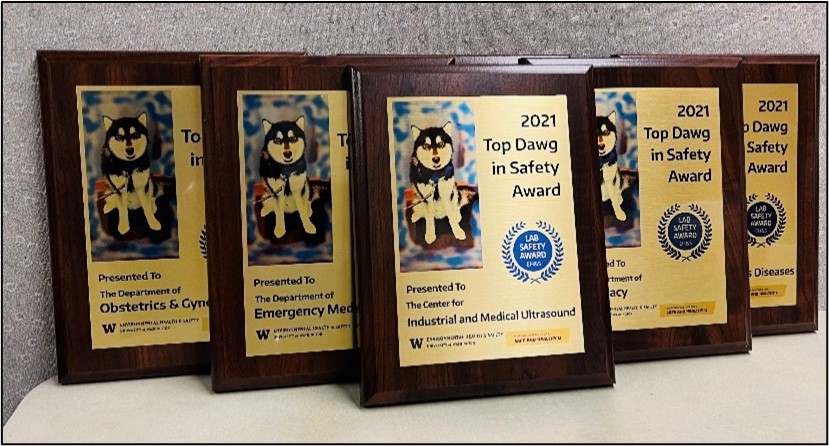2021 EH&S Lab Safety Awards & Innovations Event
The 2021 Laboratory Safety Awards & Innovations Event honored 20 labs, departments and individuals to recognize their significant contributions to enhancing the culture of safety at the UW. 
The 2021 Laboratory Safety Awards & Innovations Event honored 20 labs, departments and individuals to recognize their significant contributions to enhancing the culture of safety at the UW. 
EH&S staff had an opportunity to speak with compliance inspector Chad Fisher from the Washington State Department of Ecology regarding three of the most common hazardous waste violations he's encountered at the UW. As it turns out, the majority of these violations are easily preventable and making simple corrections contributes to a safer lab environment.
Awards were given to labs, departments, and personnel in recognition of their achievements in safety culture.
The 2021 award winners for Top Dawgs in Safety:
The 2021 award winners for Pack Leaders in Safety:
The 2021 UW Biosafety Manual is now available online. All laboratories or facilities using biohazards must have an electronic link or paper copy of the current manual available to all personnel working in the lab or facility.
A new Notice of Cleaning and/or Decontamination Form was published in August 2021 to replace the prior decontamination form. The new form contains expanded information to include cleaning as well as decontamination procedures for lab instruments, equipment, appliances, and furniture.
October is National Biosafety Month, a time to focus on your lab’s biosafety policies and procedures. For 2021, EH&S would like labs to focus on the importance of wearing lab coats. Lab coats are an important barrier between your skin or clothes and any hazards that you work with in the lab. Not only do lab coats protect you from exposure, they also help prevent you from transporting laboratory contamination home to your family, friends and pets.
A person can be seriously injured, even killed, when working on a machine or equipment if the hazardous energy sources are not controlled.
Several recent incidents have occurred at the University in which a chemical or infectious material splashed or splattered into the eye because the individual was not wearing the correct type of eye protection for the hazards they faced, or not wearing eye protection at all. You should always evaluate your workplace for potential eye hazards so you can select the appropriate safety equipment.
Eyeglasses versus safety glasses or goggles
Stormwater drains on the UW campuses empty directly into local waterways, which can carry pollution that harms wildlife, such as birds and fish. Campus activities can put the surrounding natural areas at risk when garbage, oils, chemicals and other potentially harmful substances are allowed to flow into stormwater drains.
University faculty, staff, and students must complete an animal use health screening prior to work in any University animal care and use environment to evaluate and address potential health risks related to working with research animals.
You can help speed up the health screening process by following these tips when completing the online Animal Use Medical Screening (AUMS) form:
1. Verify your contact Information.